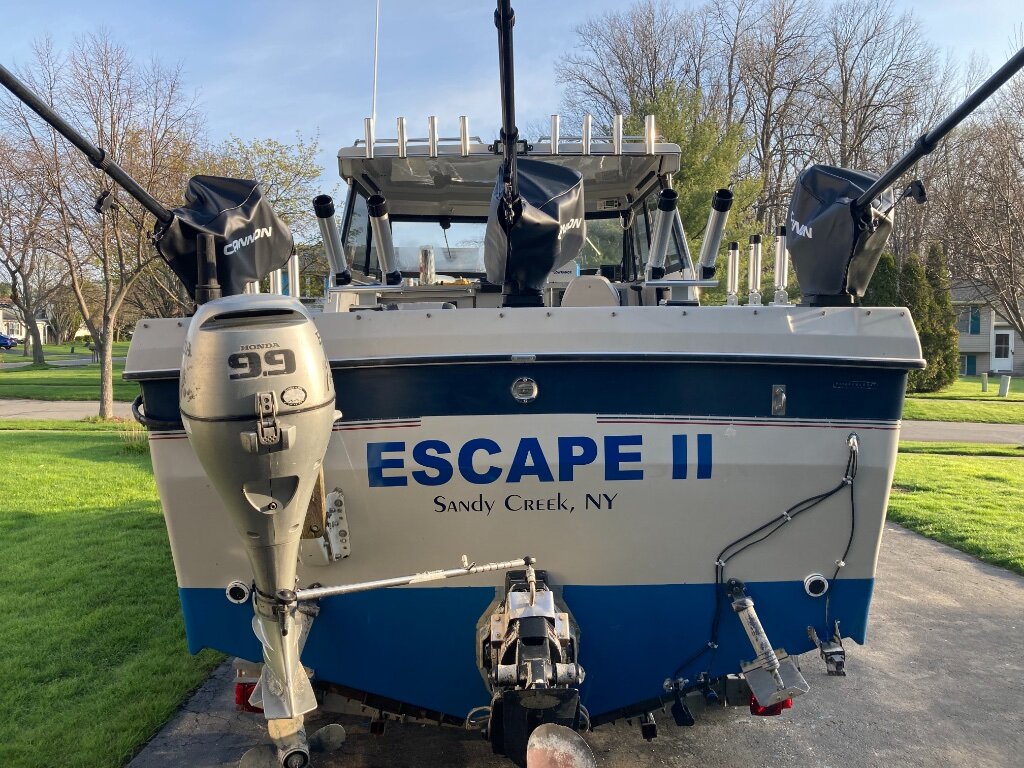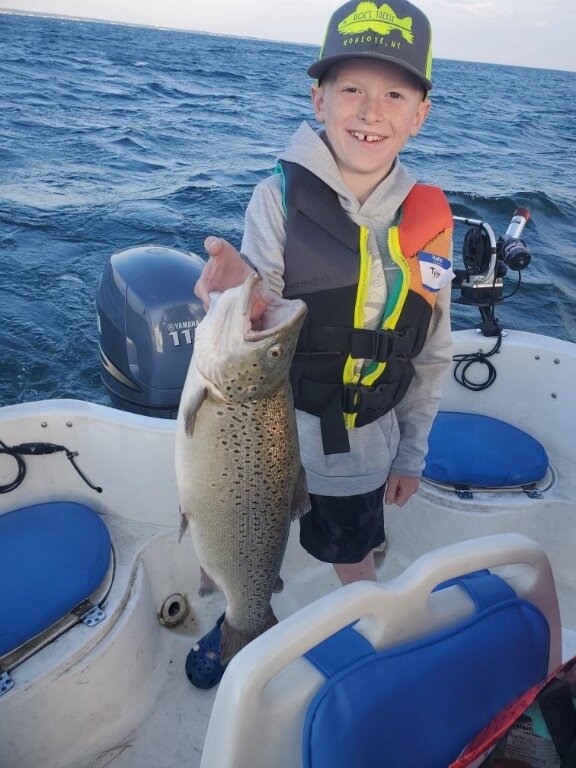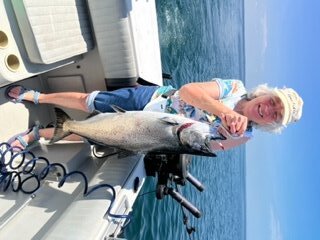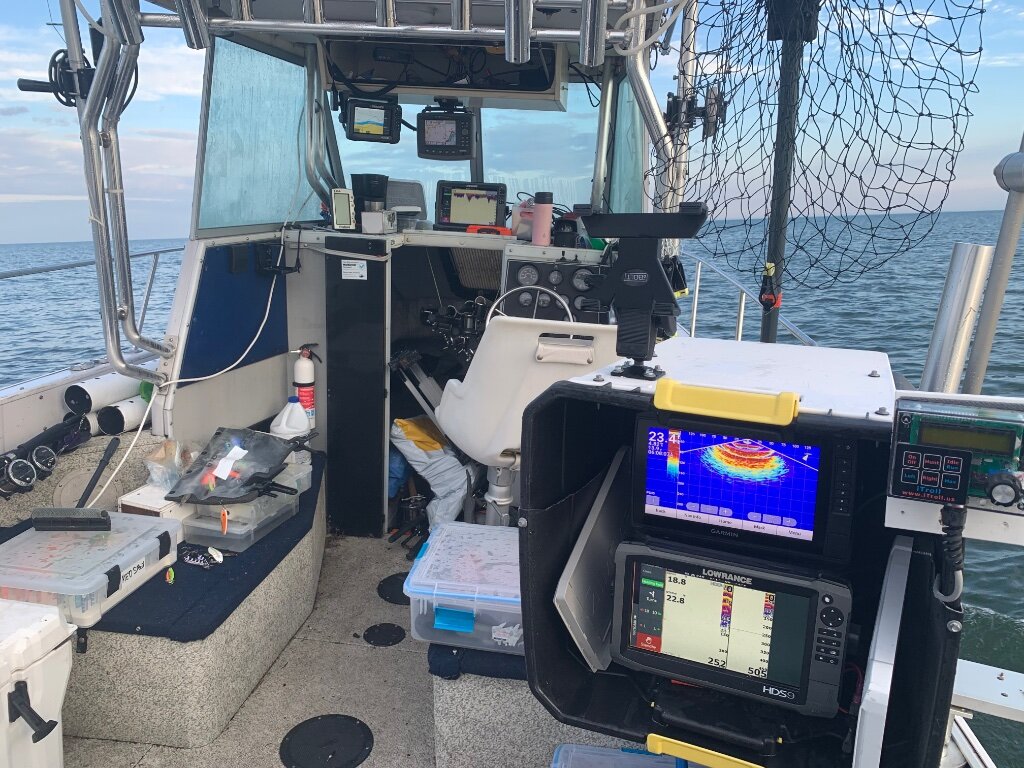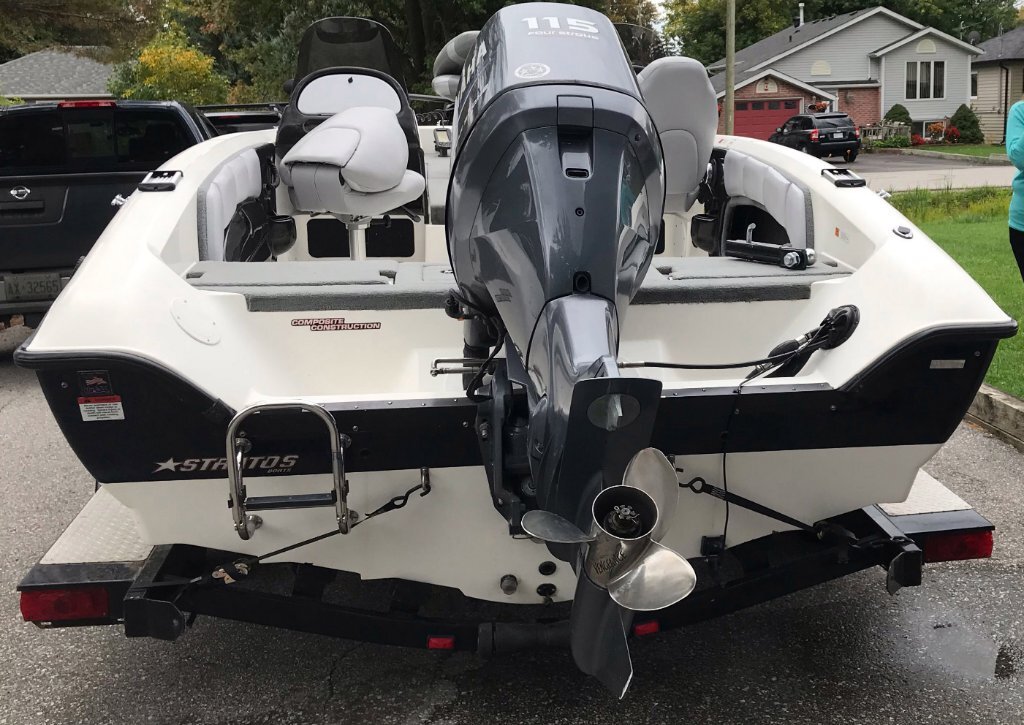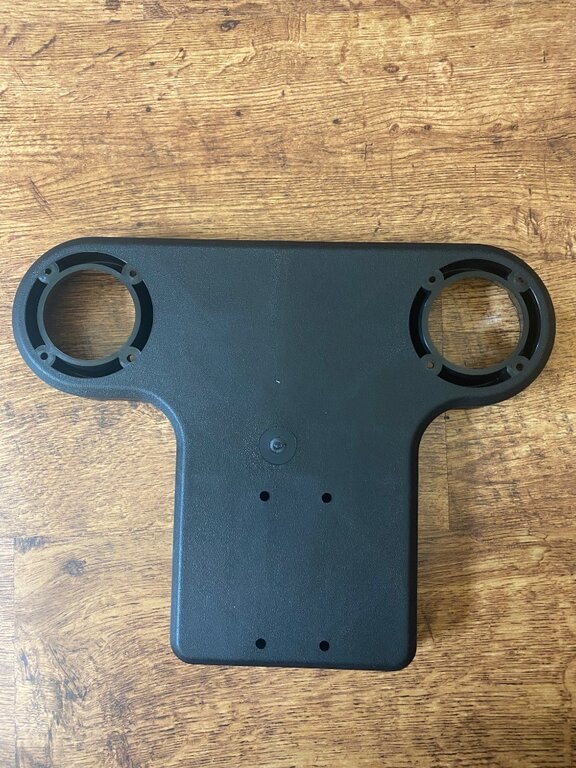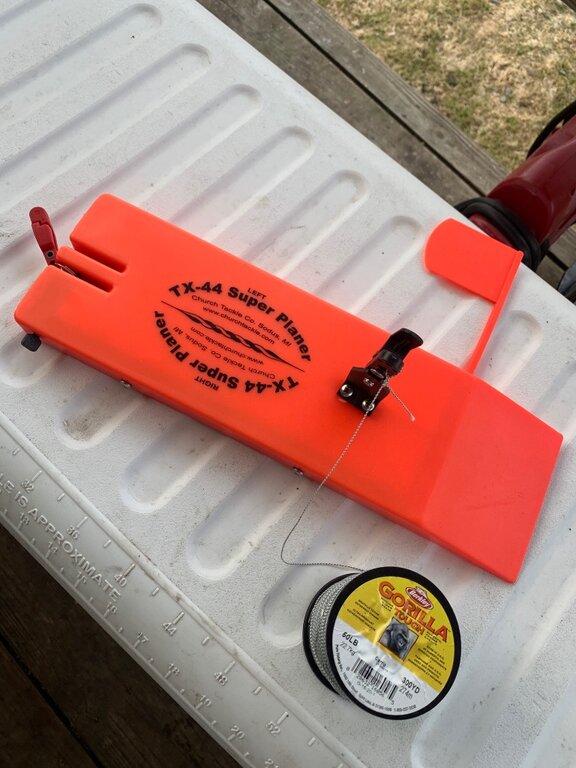-
Posts
508 -
Joined
-
Last visited
Content Type
Profiles
Forums
Events
Gallery
Store
Everything posted by mudflat
-

Sandy 7/16 and 7/17
mudflat replied to GAMBLER's topic in New York Fishing Reports - Lake Ontario (South Shore)
Jetsled, here are some pictures of my Intruder's kicker setup with an Adventure Marine bracket. The T9.9 has an extralong shaft (25") and a TR-1 auto pilot. Does a pretty good job unless the wind/currents are really strong then I will drop in some trolling bags, start the main motor up with the steering locked strait and use the kicker to steer and fine tune my speed. Not trying to steal this thread, just another way of getting the job done for your reference. -

Need details on how people have hooked up their Smart Troll probes
mudflat replied to chowder's topic in This Old Boat
Another gen 1 user with mixed results, some probes work well and some don't work at all. It would be nice if they would offer an upgrade program for us original users. On regular divers I just attach the probe to the end of my wire and then hook the diver to the probe. I've also attached the probe to the tail end of the diver then attached the leader to the probe. You will be surprised to see how much the divers move up and down depending on the currents. I use wire for my slide divers with about 30-40' of 40lb big game for the diver to slide on. I hook the probe in line between the 40lb big game and a 6' flouro. leader. I do the same thing for my coppers with the probe between the mono leader and a 6' flouro. leader. Usually I use 20lb test for the flouro for spoons and 30lb for flashers. I've thought of putting some tape on the probe so it would act as an attractor but haven't tried it yet. -

Happy kid
mudflat replied to Morningdew's topic in New York Fishing Reports - Lake Ontario (South Shore)
-
Finally starting to see some better fish in Sodus Marked lots of bait in 120-150 and had temp down 100 in the morning, later in the afternoon temp disappeared as warm water moved in. We did 5 kings including a couple nice teenagers, one on a 240' dipsy with a mirage fly other one came on rigger down 115' with a shelly snack spoon. choose files... Even got some lake poop on the boat's floor for the first time this year😒
- 1 reply
-
- 7
-

-
http://content.govdelivery.com/attachments/fancy_images/NYSDEC/2015/08/586183/decdeliversbanner_original.jpg DEC Delivers - Information to keep you connected and informed from the NYS Department of Environmental Conservation Share or view as a web page || Update preferences or unsubscribe The Fishing Line - Great Lakes Spring Edition Freshwater Fishing, Fisheries Management, and Fishing Access News In This Issue: Lake Erie Open Lake Angler Survey Update - May 2022 Lake Ontario Surveys Over 2.4 Million Salmon and Trout Stocked in Lake Ontario this Spring Lake Erie Open Lake Angler Survey Update - May 2022 Warm weather and calm winds surely contributed to an increase in angling activity on Lake Erie during the month of May. Total angler effort in May 2022 was 53,000 angler hours which is well above the 20-year average (40,250 angler hours). A large majority of May anglers (70%) targeted walleye or smallmouth bass. Walleye: Daytime walleye angling effort in May has become more popular on Lake Erie in recent years, with 19,400 angler hours spent (average = 7,195 angler hours). Although May effort is typically low compared to the summer months, this was the highest targeted walleye effort for the month of May in the last 20 years, with most walleye anglers fishing out of Buffalo (75%). Anglers targeting walleye harvested 2 fish per boat trip on average, with a catch rate of 0.23 fish per hour, the 3rd highest May catch rate for walleye in the last 20 years, behind only 2019 and 2020. About 2% of daytime walleye anglers achieved a 6 fish limit this May with an average size of 20.3 inches. Smallmouth Bass: Smallmouth bass fishing is very popular in the New York waters of Lake Erie during the month of May, with many anglers focusing inside and outside of the harbors in Dunkirk (28%) and Buffalo (58%). This May was no exception, with anglers spending over 17,500 hours targeting smallmouth bass. However, the May bass fishing quality was below average in 2022, with anglers targeting bass catching an average of 15 bass per boat trip with a catch rate of 1.11 fish per hour, the 4th lowest May catch rate for smallmouth bass in the last 20 years (May average = 1.48 fish per hour). Yellow Perch: Yellow perch angling effort was up significantly from the previous two years, with 12,600 angler hours spent targeting yellow perch in May (average = 9,645 angler hours). Yellow perch fishing was steady with the majority of perch anglers focusing their efforts off from Cattaraugus Creek (82%). Anglers targeting yellow perch were rewarded with an average of 18 perch harvested per boat trip and a catch rate of 1.59 fish per hour, the 9th highest May catch rate in the last 20 years (May average = 1.65 fish per hour). About 2.5% of yellow perch anglers achieved a 50 fish limit with an average size of 11.4 inches. Lake Erie Fisheries Research and Management Lake Ontario Surveys Creel Survey The open lake portion of the Lake Ontario creel survey is currently underway and will continue through September 15th. Since 1985 this survey has been conducted to track angler effort, angler catch rates and harvest, and monitor average weights of species to inform the public and fisheries managers about the status of Lake Ontario’s fish community and the quality of the fishery. The success of the survey relies on the outstanding cooperation from our angling public to provide the information and data necessary to manage the fishery. Several thousand fishing boats contribute to interviews each year, so if you see the DEC creel survey boat on the water, please slow down and participate in the survey. Beginning later this year the Lake Ontario creel survey will also cover the tributary fishery every year. (Previously, tributary creel surveys were done every 3-5 years). The tributary creel survey will begin on September 15th and run through April 15th. Spring Preyfish Survey The Lake Ontario spring preyfish survey was completed in April 2022. This annual bottom trawl survey is a collaborative effort by the U.S. Geological Survey (USGS), DEC, and the Province of Ontario. Our DEC crew participates in the survey using our 47’ research vessel, the R/V Seth Green. In 2022, the Seth Green crew conducted 77 bottom trawl samples between Rochester and Cape Vincent. The crew also implemented a digital data collection system, streamlining data entry and reducing the need for paper datasheets. The new system allows data to be recorded directly to a database from digital scales and measuring boards, reducing transcription error and vastly improving data processing time. The complete report on the lakewide survey will be prepared by scientists from the USGS and should be available by the end of summer. Over 2.4 Million Salmon and Trout Stocked in Lake Ontario this Spring Salmon and trout stocking in Lake Ontario is complete for 2022 with 900,000 Chinook salmon, 505,200 rainbow trout, 480,000 brown trout, 320,000 lake trout, 121,000 coho salmon, and 125,000 Atlantic salmon to provide exceptional angling opportunities. Stocking included traditional shore stocking, as well as two specialized stocking methods: pen-rearing and offshore barge stocking. DEC also entered into an agreement with the U.S. Department of Agriculture, Animal, Plant Health Inspection Service (APHIS) to haze and disperse Double Crested Cormorants at some stocking locations in 2022. Pen-rearing Pen-rearing is a cooperative program where Chinook salmon, steelhead, and Atlantic salmon are stocked into net pens located at the stocking site and cared for by volunteers for 3-4 weeks prior to release. This stocking method has been shown to improve post stocking survival and adult returns to the stocking site. All Chinook salmon stocked in New York waters of Lake Ontario are either pen-reared or are Salmon River Hatchery broodstock (which are held in the hatchery longer and have similar survival to pen-reared fish), with smaller numbers of steelhead and Atlantic salmon stocked into pens. Approximately 600,000 Chinook salmon, 58,000 steelhead, and 15,000 Atlantic salmon were held in net pens in 2022. The pen-rearing program continues to be an outstanding, volunteer-based project that provides great benefits to the Lake Ontario fishery. Offshore Barge Stocking All lake trout stocked in Lake Ontario and all brown trout stocked in the eastern end of the lake (Stony Point to Fairhaven) are typically stocked offshore using a military landing craft that carries stocking trucks out to release fish over deeper water, reducing predation by fishing eating birds such as Double-crested cormorants. In 2022, all barge stocking targets were met, except for lake trout stocked at Stony Point. These fish were shore stocked due to poor weather conditions on the day of stocking. Double-Crested Cormorant Hazing Cormorant hazing crews from APHIS were present for 18 days, covering 13 stocking events, and protecting 815,930 stocked fish at several locations on Lake Ontario this year. Cormorant populations have grown and expanded on Lake Ontario and pose a threat to newly stocked fish. To acclimate to their new environment, large groups of these fish stay close to their stocking site making them especially vulnerable to bird predation. Hazing and dispersing cormorants away from these areas gives newly stocked fish a better chance of survival. Fishing in Lake Ontario has been outstanding in recent years and DEC’s fish culture and stocking programs should ensure continued fishing success in the future. For more information about fisheries management in Lake Ontario contact the Lake Ontario Fisheries Unit or visit the Lake Ontario/St. Lawrence River research webpage. The New York State Department of Environmental Conservation respects your right to privacy and welcomes your feedback | Update preferences or unsubscribe | Learn more about DEC Delivers Connect with DEC: http://content.govdelivery.com/attachments/fancy_images/NYSDEC/2015/07/565841/facebookicon_original.jpg http://content.govdelivery.com/attachments/fancy_images/NYSDEC/2015/07/565842/twittericon_original.jpg http://content.govdelivery.com/attachments/fancy_images/NYSDEC/2015/07/567473/youtubeicon_original.jpg Basil Seggos, Commissioner
-
Congrats on your new ride On my 255 the fish boxes drain into the bilge so I always figured if I was going to use them I would need to hook up a macerator pump to them or there would be a definite odor after a while. They are also not insulated so I don't think they would hold ice very well. I use them for storing life jackets and extra fenders. I have dinette seating so I use a cooler on the port side in back of the seats. Serves as additional bench seating and I still have enough room to work around between it and the dog house. Might be a little tighter on a 245? If you have a swim platform I've seen a lot of coolers strapped back there.
-
It's been that way for awhile now, started back in September https://www.lakeontariounited.com/fishing-hunting/forum/21-lou-professional-members-only/ Posted September 27 I don’t like the way it jumps back to the beginning everytime I close a topic. This kinda sucks? Any advice???
-
105-Pound River's Inlet King! - JD Richey – Salmon Trout Steelheader 105-Pound River's Inlet King! - JD Richey History was made off the British Columbia coast last August, when a lady angler landed what is perhaps the largest Chinook salmon ever hooked on sport gear—a fish in the mythical 100-plus-pound class! Gayle Gordon and her husband John were fishing near Dawson’s Landing in the fabled River’s Inlet area (in their own boat which they had dragged and ferried from their home Duncan, B.C.) when the monster struck. Gayle Gordon with the fabulous mount made by Advanced Taxidermy. As you can imagine, there aren’t a whole lot of fiberglass replica blanks of 105-pound kings laying around, so they had to make a custom mold for Gayle’s fish. “It was my turn to run the rods while John ran the boat,” says Gordon. “We were mooching cut-plug herring down about 25 feet, and when the fish bit, the head-shakes were so violent, so strong. Up there because of the water color, you can’t see the fish until they break the surface but I knew that this was something unbelievable!” And the Gordons know a thing or two about hooking big kings. They started fishing together 35 years ago on their first date and have been hard at it every year since then. They’ve caught and released 13 Chinook over 50 pounds at River’s Inlet, including three in the 60’s, two in the 70’s, an 82.43 pounder and one just under 85 pounds! Gayle says that the fish she hooked in August was in an entirely different class than any of their previous giants. She fought the fish on her Temple Fork rod and Islander MR2 “knuckle buster” mooching reel for 45 minutes before getting a look at it. During that time, a crowd of boats gathered around to watch the action. “The people up there are so awesome and very courteous,” she says. "Basically, the whole fleet saw us catch it. They made a circle around us and watched—and when we got it, they went nuts.” Gayle says she still doesn’t have words to describe what she was feeling when the behemoth finally came to the net. “He was brilliant chrome and not a mark on him,” she says. “What an amazing, amazing fish!” The Gordons scrambled to get some measurements on the fish—and they did so three times just to make sure they got it right and then posed for a couple quick photos which were taken by boats floating around them. In short order, the estimated 7-year-old monster was back in the water and swimming free. Now, here’s where things get really interesting. The king taped out at a whopping 55 inches (an inch longer than the bottom width on my first drift boat) and had a mind blowing 38-inch girth! Because they let the fish go, the Gordon’s don’t have an official weight on their salmon but they put it into the ol’ tried and true 750 weight formula (Weight = Length x Girth x Girth /750) and it came out to 105.9 pounds! Now, obviously weight formulas have some wiggle room as far as results go because fish come in all different shapes and sizes, so I decided to run it through some other ones just for fun. The first one I tried was the Steelhead/Salmon Weight Calculator on www.piscatorialpursuits.com. I’m not sure what the formula is that they use, but when I punched the measurements in, the big king came out at 102.4 pounds. On the Ally McGowan Formula, used for Atlantic salmon (found on www.wherewisemenfish.com), 55x38 gets you 120.5 pounds! I also found a calculator at http://www.csgnetwork.com/ (not sure of their formula) but the king came out to 122.1 pounds. Sometimes, folks also use the 800 formula (which is the same as above, just divided by 800 instead of 750) but I think that one is designed more for fish like trout and steelhead and doesn’t really well represent the girth of Gayle’s king. Even underestimated with this method, her fish comes out at an incredible 99.28 pounds. Okay, so now let’s take a look at how Gayle’s Chinook measures up to fish with known weights. Les Anderson’s IGFA All-Tackle World Record king from the Kenai River in Alaska weighed 97 pounds, 4 ounces and measured 58.5 inches with a girth of 37 inches. Her fish was a bit shorter and a tad bigger around than Anderson’s. The thing with the Kenai fish is Anderson threw it in the bottom of the boat on a hot day and fished for several hours—and then it rode around in the back of his truck for quite a while. It was never iced and the photos of it show the fish is very dehydrated. I think it’s easy to assume that king probably weighed 100 plus pounds when it was initially caught. In August of 2001, a massive king was caught and released on the Skeena River in B.C. by clients fishing out of Kermode Bear Fishing Lodge in Terrace, BC. That leviathan measured 53.5 x 38.5, which comes out to 105.7 pounds on the 750 formula above (and 99 and change using the 800 formula). Gayle and John are no strangers to trophy kings. John Gordon about to release a huge king salmon caught at River’s Inlet. Obviously, we’ll never know the precise weight of Gayle’s fish but it’s safe to say that it was clearly over 100 pounds, which just boggles the mind. A pound here or there in either direction really doesn’t matter—the real story is she caught a fish that would, almost certainly, be the new all-tackle world record, but she decided to forgo the glory and release it instead! In this day and age of declining Chinook stocks—especially the true giants—it was truly a selfless act. “The culture is changing up there at River’s Inlet,” she says. “Lots and lots of boats are measuring and releasing their big fish now which is great. Really the only way to get IGFA to recognize our fish as a true record was to kill it and I didn’t want to do that. I’m just so humbled to have been able to catch him. It was so cool!” Sadly, doing a hero shot on board is a tall order with a fish of that size when you’re not keeping it, so the Gordon’s don’t have any good photos of their amazing catch. There are several shots taken from other boats, but they don’t do much justice to this king of kings. What does do it plenty of justice, however, is the fabulous mount that Advanced Taxidermy made of it. As you can imagine, there aren’t a whole lot of fiberglass replica blanks of 105-pound kings laying around, so they had to make a custom mold for Gayle’s fish. “It’s absolutely amazing…. Advanced really nailed it,” she says. “I feel so blessed—we were obviously fishing for big fish up there but I never dreamed of getting one that size! I caught the fish, but it really was a team effort with my husband John. After that, I gave him the next three chances on the rods in a row.” The Gordon’s obviously didn’t need any more inspiration to return to River’s Inlet next year, but just to remind them that there are potentially even bigger kings to be caught, owners Rob and Nola Bachen dusted off and showed them the mount of a 126-pound king they had in storage. The enormous king was caught by a commercial boat back in the 1960’s “It was truly an honor to see that fish,” she says.
- 1 reply
-
- 1
-

-
http://content.govdelivery.com/attachments/fancy_images/NYSDEC/2015/08/586183/decdeliversbanner_original.jpg DEC Delivers - Information to keep you connected and informed from the NYS Department of Environmental Conservation Share or view as a web page || Update preferences or unsubscribe The Fishing Line - The Salmon Are Running! Freshwater Fishing, Fisheries Management, and Boating News In This Issue: Lake Ontario Tributary Fishing Lake Erie Steelhead: 2021 Fall Fishing Forecast Fishing Finger Lakes Tributaries Salmon River Hatchery Update Saranac River Atlantic Salmon Run Fish Fact Friday The start of Fall signifies several things here in New York - apple picking, pumpkin spice everything, football games and...(most important) the annual trout and salmon run in New York's larger tributaries. Lake Ontario Tributary Fishing With higher than average water levels, good runs of migrating salmon and trout are expected in Great Lakes tributaries this fall. Anglers can expect quality fishing opportunities for Chinook and coho salmon from now through early-November, but the first two weeks of October is when it typically peaks. Steelhead fishing turns on later in the season, usually in late October through November when water temperatures are around 45-58 degrees F. And lest we forget brown trout where world-class waters such as Niagara River, Oswego River, Oak Orchard Creek, Eighteenmile Creek, Sandy Creek and Maxwell Creek provide peak fishing opportunities in November and December. For information on fishing Great Lakes tributaries, visit the DEC website. Lake Erie Steelhead: 2021 Fall Fishing Forecast New York’s Lake Erie tributaries boast some of the highest angler catch rates for steelhead (PDF) in the entire country, and the arrival of fall’s colors signals the beginning of the steelhead season. This year is shaping up to be a more “typical” fall on the Lake Erie tributaries compared to the hot and dry conditions in recent years. Plenty of rain in recent weeks coupled with cooler temperatures has already brought in the first runs of steelhead into the lower sections of favorite fishing destinations such as Cattaraugus, Eighteen Mile, and Chautauqua creeks. As long as this pattern continues, anglers should experience excellent fishing in October and November. Expect a lot of jacks in the early going with larger fish becoming more plentiful as the water temperatures cool off. Anglers looking for current water conditions can look online at the USGS water gauges for all of the major Lake Erie tributaries, or visit the DEC Lake Erie Fishing Hotline for weekly updates on the steelhead fishery. Steelhead Fishing in Lake Erie Tributaries Fishing Finger Lakes Tributaries Anglers that prefer to avoid crowds and get in on some high quality tributary fishing should consider setting their sights on New York's Finger Lakes. Of the 11 Finger Lakes, nine have annual migratory trout and salmon runs, so there is no shortage of opportunities to choose from. Pair a fishing trip with a wine tasting for a fun fall Finger Lakes weekend. For information on tributary access (Public Fishing Rights) visit DEC's website. Salmon River Hatchery Update The new fish ladder at the Salmon River Hatchery is up and running, and fish have wasted no time using it. Construction crews continue to lay the foundations for an improved outdoor visitor experience, pouring lots of concrete pillars and pads for new observation decks, a new pavilion, new roadways, and an access ramp to the back of the Hatchery's "spawn house." Although the construction will keep the hatchery closed to the public through the fall, the fall egg collection will go on as planned. This much anticipated event generally takes place beginning the day after Columbus Day as long as the hatchery's water temperatures have come down to acceptable levels. A Facebook Live event during the spawn is planned for a day the week of October 11th. Be sure to check DEC's Facebook page for a scheduled date. Saranac River Atlantic Salmon Run With much cooler nights and increased rainfall, the fall Atlantic salmon run has begun. Anglers are catching salmon all the way to below the Imperial Mills Dam. Please be advised that DEC and the U.S. Fish and Wildlife Service are currently netting salmon in the river as part of a research project but are returning all fish back to the river after a sample is collected. We have received reports of some quality fish. Fish Fact Friday After hatching, Chinook salmon spend just four months in a tributary before taking a trip downstream to spend a majority of their life in Lake Ontario, whereas coho salmon spend 1½ years in tributaries before migrating out to the lake. The New York State Department of Environmental Conservation respects your right to privacy and welcomes your feedback | Update preferences or unsubscribe | Learn more about DEC Delivers Connect with DEC: http://content.govdelivery.com/attachments/fancy_images/NYSDEC/2015/07/565841/facebookicon_original.jpg http://content.govdelivery.com/attachments/fancy_images/NYSDEC/2015/07/565842/twittericon_original.jpg http://content.govdelivery.com/attachments/fancy_images/NYSDEC/2015/07/567473/youtubeicon_original.jpg Basil Seggos, Commissioner This email was sent using GovDelivery Communications Cloud on behalf of: New York State Department of Environmental Conservation · 625 Broadway · Albany, NY 12233 · (518) 402-8013
-

Can a iPad clone the display from a Lowrance HDS gen 3 display?
mudflat replied to chowder's topic in This Old Boat
-
A picture of your boat and transom would be helpful. On that size boat I doubt the extra weight from a kicker would create any problems but you could test it out by having someone sit on the port transom and see how the boat reacts to the extra weight. Other things to consider: Are you looking at a remote control kicker or are you going with a tiller model? How are you planning to steer the kicker? Do you have an auto pilot now or plan one in the future? How do you want to control the throttle? Do you have easy access to the kicker where it will be mounted or will you want electric start and trim? Can you mount the kicker directly onto you transom or will you need a bracket? My main point is to plan everything out before purchasing anything
-
X2 John Mann - 315-871-6400
-
-
They are posted on their web site https://soduspointproam.com/2021-live-results/
-
If you ever need to remove your B60 you will wish that you had used 4200 instead of 5200 sealant.
-
Late start and blown off around 1 4/4, all kings, 3 of them on same dipsy rod with green crinkle fly and a white/green dot spinny Mag dipsy out 240’ set on 2 200-220’ Sent from my iPhone using Lake Ontario United mobile app
-

New ON/OFF/ON switch for old Walker Deep Troller downrigger?
mudflat replied to 1lastweekend's topic in This Old Boat
-
Water levels on Lake O right now are about a foot lower than average for this time of year and about 2 foot lower than last year https://lre-wm.usace.army.mil/reports/GreatLakes/GLWL-CurrentMonth-Feet.pdf
-
This bracket from Adventure Marine is rock solid, a little pricey but you only buy once. https://adventuremarine.ca/product/high-thrust-outboard-motor-bracket/
-
https://baybridgesportshop.com/
-
As long as your line releases on a hit it should work but if the board drags back and it doesn't release you would probably have a mess. You would also have to retrieve the board on the dacron after every release to reset. It would eliminate having to fight a fish with a board on your line but I'm not sure what advantage this would have compared to a mast and otter board setup on a boat?
-
IJC lowered the outflow yesterday Let's hope that with this decrease and some rain the lake levels start coming up again Lake Ontario Outflow Changes FacebookTwitterLinkedIn DATE HOUR/ FROM/DE TO/À (YYYY-MM-DD) HEURE (m3/s) (ft3/s) (m3/s) (ft3/s) 2021-04-10 0001 7,980 281,800 7,420 262,000 2021-04-03 0001 7,380 260,600 7,980 281,800 2021-03-20 0001 8,000 282,500 7,380 260,600 2021-03-13 0001 8,080 285,300 8,000 282,500 2021-03-06 0001 8,140 287,500 8,080 285,300 2021-03-01 0001 8,600 303,700 8,140 287,500 2021-02-21 1501 8,400 296,600 8,600 303,700 2021-02-20 1201 8,000 282,500 8,400 296,600 2021-02-19 1201 7,600 268,400 8,000 282,500 2021-02-18 1801 7,400 261,300 7,600 268,400 2021-02-18 0701 7,000 247,200 7,400 261,300 2021-02-17 1101 6,600 233,100 7,000 247,200 2021-02-16 1401 7,000 247,200 6,600 233,100 2021-02-12 1401 7,400 261,300 7,000 247,200 2021-02-11 1601 8,300 293,100 7,400 261,300 2021-02-10 1901 8,500 300,200 8,300 293,100 2021-02-09 2001 8,800 310,800 8,500 300,200 2021-02-05 1801 8,200 289,600 8,800 310,800 2021-02-04 1201 7,700 271,900 8,200 289,600 2021-02-03 1401 7,100 250,700 7,700 271,900 2021-02-01 1501 6,900 243,700 7,100 250,700 2021-01-31 1801 7,200 254,300 6,900 243,700 2021-01-28 1601 7,700 271,900 7,200 254,300 2021-01-26 1001 7,200 254,300 7,700 271,900 2021-01-24 1701 8,400 296,600 7,200 254,300 2021-01-23 1701 9,200 324,900 8,400 296,600 2021-01-19 1501 9,400 332,000 9,200 324,900 2021-01-16 1701 9,200 324,900 9,400 332,000 2021-01-14 1201 9,500 335,500 9,200 324,900 2021-01-12 1201 9,400 332,000 9,500 335,500 2021-01-09 1501 9,300 328,400 9,400 332,000 2021-01-07 1301 9,200 324,900 9,300 328,400 2021-01-05 1001 9,400 332,000 9,200 324,900 2021-01-04 1701 9,500 335,500 9,400 332,000 2021-01-03 1301 9,400 332,000 9,500 335,500 2021-01-01 0801 8,090 285,700 9,400 332,000 2020-12-26 0001 8,110 286,400 8,090 285,700
-
http://content.govdelivery.com/attachments/fancy_images/NYSDEC/2015/08/585851/decdeliverspress_original.jpg DEC Delivers Press Release - Information to keep you connected and informed from the NYS Department of Environmental Conservation Share or view as a web page || Update preferences or unsubscribe DEC Announces Net Pen-Rearing Projects for Atlantic Salmon in Lake Champlain and Lake Ontario Following Success of Net Pen Programs for Other Species, DEC Anticipates Increased Survival of Stocked Smolts New York State Department of Environmental Conservation (DEC) Commissioner Basil Seggos today announced the deployment of two new pen-rearing projects for Atlantic salmon to begin this spring. To improve post-stocking survival and imprinting to the stocked water, experimental Atlantic salmon pen-rearing projects will be conducted in the Saranac River estuary in Lake Champlain and in the Salmon River in Lake Ontario. DEC is partnering with the Lake Champlain Chapter of Trout Unlimited, the U.S. Fish and Wildlife Service and the Plattsburgh Boat Basin on the Saranac River project and partnering with the Tug Hill/Black River Chapter of Trout Unlimited and Salmon River Lighthouse and Marina on the Salmon River project. "Atlantic salmon are a highly prized sport fish," said Commissioner Seggos. "Working with our partners from Trout Unlimited and the U.S. Fish and Wildlife Service, DEC hopes to increase the survival of stocked salmon smolts for greater returns of adults to tributaries for improved angling opportunities and spawning in these two major fisheries I want to personally thank Trout Unlimited for helping make this possible as TU will be doing the day-to-day work to feed and care for these fish while they are in the pens." Pen-rearing is a process in which young salmon (smolts) are stocked into net pens and held at the stocking site. At this life stage, the salmon will imprint on the river water and prepare to out-migrate to the lake system. The Trout Unlimited chapters will feed and care for the fish for approximately three weeks prior to release. DEC has been partnering with volunteer groups to pen-rear Chinook salmon and steelhead in Lake Ontario and Lake Erie for more than 20 years, and this method has improved the survival and imprinting for both species. Today's announcement is the first project to test if pen-rearing can have a similar beneficial impact on stocked Atlantic salmon. Andrew Milliken, Project Leader and Complex Manager for Lake Champlain Fish and Wildlife Conservation Office said, "The U.S. Fish and Wildlife Service looks forward to working with DEC, Trout Unlimited and the Lake Champlain Fish and Wildlife Management Cooperative on this cutting edge project in the Saranac River to learn and improve returns of landlocked salmon to Lake Champlain tributaries, enhance tributary fisheries and increase natural reproduction." Rich Redman, President of Trout Unlimited Lake Champlain Chapter said, "Landlocked Salmon are our chapters priority. This is one step to restore wild Atlantic salmon to the Saranac River. Now is the time to restore the river habitat itself, to allow the cold water species like salmon to once again thrive." Wayne Weber, President of Trout Unlimited Tug Hill/Black River Chapter said, "The Salmon River provides one of the most diverse angling opportunities in our region. Currently Atlantic salmon are a small portion of that opportunity. We are hoping the pen rearing project will provide greater returns to Salmon River therefore increasing the angler's chance of success." Each project will compare two lots of Atlantic salmon smolts to evaluate the effectiveness of pen-rearing as a stocking method. One lot of Atlantic salmon will be stocked into net pens and held for approximately three weeks prior to release. A second lot will be directly stocked into the water at the same site when the smolts are released from the pens. A comparison of returns between the two stocking methods will determine if pen-rearing results in greater survival and homing than conventional, direct stocking. For more information about salmon in New York State, visit DEC's Salmon and Atlantic salmon websites. https://www.dec.ny.gov/press/press.html The New York State Department of Environmental Conservation respects your right to privacy and welcomes your feedback | Update preferences or unsubscribe | Learn more about DEC Delivers Connect with DEC: http://content.govdelivery.com/attachments/fancy_images/NYSDEC/2015/07/565841/facebookicon_original.jpg http://content.govdelivery.com/attachments/fancy_images/NYSDEC/2015/07/565842/twittericon_original.jpg http://content.govdelivery.com/attachments/fancy_images/NYSDEC/2015/07/567473/youtubeicon_original.jpg Basil Seggos, Commissioner This email was sent to xxxxxxxxxxxxx using GovDelivery Communications Cloud on behalf of: New York State Department of Environmental Conservation · 625 Broadway · Albany, NY 12233 · (518) 402-8013
-
Only problem with your guesstimate is that on 4/3 they increased the outflow to 281,800 cubic feet/min. This is the maximum flow rate allowed: https://ijc.org/en/loslrb/watershed/outflow-changes The 2021 Seaway navigation season is open as of 22 March. For the coming week, the average Lake Ontario outflow is expected to be 7980 m³/s, which is the Plan 2014 maximum “L-Limit” that applies at the current level of Lake Ontario (74.56 m). Plan 2014’s “L-Limit” flow is the maximum flow that can be released while maintaining adequate levels and safe velocities for navigation in the International (Upper) Section of the St. Lawrence River. I always try to give them the benefit of the doubt but I am having a hard time understanding why they would increase the flow with the current lake levels being so low and no major precipitation in the forecast?????


